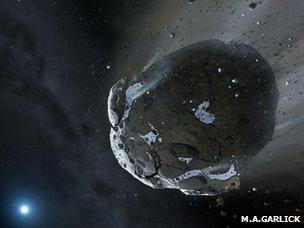Dead star eats water-rich asteroid
- Published

The scientists suspect the remains of an icy asteroid have been pulled on to the white dwarf star
Astronomers have detected the tell-tale signs of a shattered asteroid being eaten by a dead star, or white dwarf.
The Hubble telescope spotted the event some 150 light-years from Earth.
The researchers tell Science Magazine, external that the chemical signatures in the star's atmosphere indicate the asteroid must contain a lot of water.
This makes it the first time both water and a rocky surface - key components for habitable planets - have been found together beyond our Solar System.
The dead star is called GD 61. It has long since burnt through its nuclear fuel and has shrunk down to a dimly glowing ember.
But its gravity is still intense, and it is shredding rocky objects in its vicinity and pulling the debris into its outermost layers.
Runaway process
Hubble and the Hawaiian Keck observatory record how this inflow of material taints the star's atmosphere.
They detect elements such as magnesium, silicon, iron, and oxygen - the chemical ingredients of rock minerals.
Dr Jay Farihi: "Asteroids get hurled towards a white dwarf"
But what piques the scientists' interest is the abundance of oxygen.
This is far too high to be explained just from the in-fall of rock, and indicates that whatever is being dragged on to the dwarf must also contain a lot of water.
The team's calculations point to the source body being an asteroid at least 90km across and composed of perhaps 26% by mass of water.
This water content is very similar to Ceres, the largest asteroid in the main belt of our Solar System and the target of a Nasa probe in 2015, external.
By way of comparison, the Earth is a very dry object, containing just 0.02% by mass of water, and much of this was probably delivered by comets and asteroids.
The astronomers - from the universities of Cambridge and Warwick, UK, and from Kiel, Germany - speculate that a similar water-delivery system could also have occurred in the GD 61 system, which is very likely to have had rocky planets in its heyday.
Sun's future
Lead author Dr Jay Farihi told the BBC's Science In Action programme: "The reason that we can say that is that the planet-formation process starts with things as small as dust grains. They grow into things as big as pebbles and boulders and then as large as asteroids. Once you get to things as big as asteroids, planets are essentially inevitable - it's a runaway process; you simply cannot stop it.
"Having asteroids and no planets is logically possible but it's very likely physically implausible. So, we know there were rocky planets [in GD 61] because we can see the rocky building blocks; and we know there was the potential to deliver water to their surfaces because we've seen at least one very water-rich and large asteroid."
Of the 1,000 planets so far identified beyond our Solar System, none has been definitively associated with the presence of water.
For most of these objects, all that is known is a few details such as distance, size, density and the time taken to orbit the host star. The Hubble-Keck observations therefore represent the first time water has definitively been put in immediate contact with a far-off rocky surface, says Dr Farihi.
The GD 61 system also gives us a glimpse of what is likely to occur one day in the vicinity of our own star - the Sun. Billions of years into the future, it too will burn out and shrink into a white dwarf, consuming asteroids and other debris.
"I think alien astronomers would then be getting pretty similar information to what we're getting on GD 61," Dr Farihi, from the Cambridge Institute of Astronomy, explained.
"I guess it would depend on what time they looked and which asteroid they were lucky enough to catch. But we know of water-rich asteroids in the outer main belt and I think there would be a good chance that they would see a signature of something like the asteroid Ceres. And in that case, if the alien astronomers speculated about habitable planets - well, if they're looking back at our system, in that case they'd be correct."
Jonathan.Amos-INTERNET@bbc.co.uk and follow me on Twitter: @BBCAmos, external
- Published9 May 2013